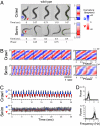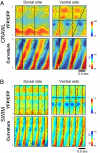Genetic analysis of crawling and swimming locomotory patterns in C. elegans
- PMID: 19074276
- PMCID: PMC2634943
- DOI: 10.1073/pnas.0810359105
Genetic analysis of crawling and swimming locomotory patterns in C. elegans
Abstract
Alternative patterns of neural activity drive different rhythmic locomotory patterns in both invertebrates and mammals. The neuro-molecular mechanisms responsible for the expression of rhythmic behavioral patterns are poorly understood. Here we show that Caenorhabditis elegans switches between distinct forms of locomotion, or crawling versus swimming, when transitioning between solid and liquid environments. These forms of locomotion are distinguished by distinct kinematics and different underlying patterns of neuromuscular activity, as determined by in vivo calcium imaging. The expression of swimming versus crawling rhythms is regulated by sensory input. In a screen for mutants that are defective in transitioning between crawl and swim behavior, we identified unc-79 and unc-80, two mutants known to be defective in NCA ion channel stabilization. Genetic and behavioral analyses suggest that the NCA channels enable the transition to rapid rhythmic behaviors in C. elegans. unc-79, unc-80, and the NCA channels represent a conserved set of genes critical for behavioral pattern generation.
Conflict of interest statement
The authors declare no conflict of interest.
Figures





Similar articles
-
A putative cation channel, NCA-1, and a novel protein, UNC-80, transmit neuronal activity in C. elegans.PLoS Biol. 2008 Mar 11;6(3):e55. doi: 10.1371/journal.pbio.0060055. PLoS Biol. 2008. PMID: 18336069 Free PMC article.
-
UNC-80 and the NCA ion channels contribute to endocytosis defects in synaptojanin mutants.Curr Biol. 2007 Sep 18;17(18):1595-600. doi: 10.1016/j.cub.2007.08.036. Epub 2007 Sep 6. Curr Biol. 2007. PMID: 17825559
-
Caenorhabditis elegans selects distinct crawling and swimming gaits via dopamine and serotonin.Proc Natl Acad Sci U S A. 2011 Oct 18;108(42):17504-9. doi: 10.1073/pnas.1108673108. Epub 2011 Oct 3. Proc Natl Acad Sci U S A. 2011. PMID: 21969584 Free PMC article.
-
Mechano-gated channels in C. elegans.J Neurogenet. 2020 Sep-Dec;34(3-4):363-368. doi: 10.1080/01677063.2020.1832091. Epub 2020 Dec 16. J Neurogenet. 2020. PMID: 33325279 Review.
-
Gap junctions in C. elegans: Their roles in behavior and development.Dev Neurobiol. 2017 May;77(5):587-596. doi: 10.1002/dneu.22408. Epub 2016 Jun 22. Dev Neurobiol. 2017. PMID: 27294317 Free PMC article. Review.
Cited by
-
Quantitative and automated high-throughput genome-wide RNAi screens in C. elegans.J Vis Exp. 2012 Feb 27;(60):3448. doi: 10.3791/3448. J Vis Exp. 2012. PMID: 22395785 Free PMC article.
-
Multi-environment model estimation for motility analysis of Caenorhabditis elegans.PLoS One. 2010 Jul 22;5(7):e11631. doi: 10.1371/journal.pone.0011631. PLoS One. 2010. PMID: 20661478 Free PMC article.
-
A multilayer circuit architecture for the generation of distinct locomotor behaviors in Drosophila.Elife. 2019 Dec 23;8:e51781. doi: 10.7554/eLife.51781. Elife. 2019. PMID: 31868582 Free PMC article.
-
Scalable Apparatus to Measure Posture and Locomotion (SAMPL): a high-throughput solution to study unconstrained vertical behavior in small animals.bioRxiv [Preprint]. 2023 Mar 27:2023.01.07.523102. doi: 10.1101/2023.01.07.523102. bioRxiv. 2023. Update in: Cell Rep. 2023 Jun 27;42(6):112573. doi: 10.1016/j.celrep.2023.112573. PMID: 36712122 Free PMC article. Updated. Preprint.
-
Novel EGF pathway regulators modulate C. elegans healthspan and lifespan via EGF receptor, PLC-gamma, and IP3R activation.Aging Cell. 2010 Aug;9(4):490-505. doi: 10.1111/j.1474-9726.2010.00575.x. Epub 2010 May 22. Aging Cell. 2010. PMID: 20497132 Free PMC article.
References
Publication types
MeSH terms
Substances
LinkOut - more resources
Full Text Sources
Research Materials

